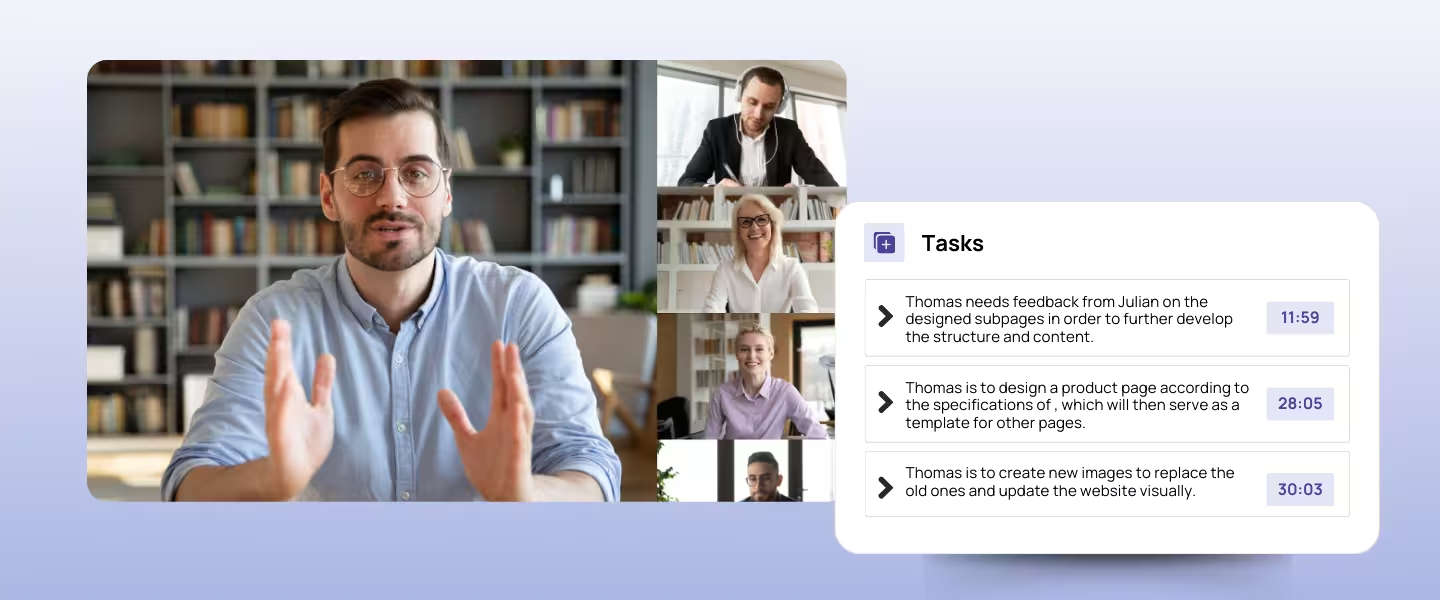Table of Contents
The working world has fundamentally changed in recent years. Remote work is no longer an exception but has become the norm for many companies. In this context, AI in remote work plays an increasingly important role as a driver for productivity and better collaboration in distributed teams.
Artificial intelligence helps solve the typical challenges of remote work: from automating time-consuming tasks to improving communication and intelligent coordination of teamwork. AI tools like Sally, which automatically record and summarize meetings, already show today how remote workflows can be optimized.
In this article, you'll learn how AI is revolutionizing remote work, what practical benefits it offers, and what challenges companies need to overcome. The goal is to provide you with a clear understanding and concrete tips for practical implementation.
How Artificial Intelligence Increases Productivity in Remote Work
Automation of Repetitive Tasks
One of the biggest advantages of AI in remote work lies in automating recurring activities. Instead of spending hours coordinating appointments or writing meeting protocols, intelligent systems take over these tasks.
AI tools can now effortlessly handle appointment scheduling, task management, and report generation. A practical example is Sally, which automatically joins video meetings, records them, and creates detailed protocols. This not only saves time but also ensures that important information is never lost.
This relief is particularly valuable for remote teams. Employees can focus on creative and strategic tasks while AI handles the routine work. This leads to higher job satisfaction and better results.

Intelligent Resource and Time Management
AI analyzes work patterns and optimizes schedules in ways that humans often overlook. It recognizes, for example, at which times of day individual team members are most productive or which tasks they complete particularly efficiently.
Tools for automatic prioritization help process the most important tasks first. They consider deadlines, dependencies, and work capacities. The result: more efficient task allocation and less stress for everyone involved.
A McKinsey study from 2023 impressively shows that up to 45% of office tasks could be automated. For remote teams, this means enormous potential for productivity increases.
Improving Communication and Collaboration Through AI
Optimized Communication Channels
Communication is the heart of successful remote work. AI makes it not only more efficient but also more inclusive. Real-time translations enable global teams to overcome language barriers and truly collaborate.
Voice-based assistants help quickly find the right information. Instead of searching through endless chat histories, employees can simply ask: "What was discussed about project X last week?"
Automated summaries of meetings and chat conversations are particularly valuable. Tools like Sally not only create protocols but also extract action items and important decisions. This ensures that all team members stay on the same page – even if they couldn't attend every meeting.
Promoting Team Dynamics and Efficiency
AI can recognize teamwork patterns that are often invisible to humans. It analyzes who communicates with whom and how often, which projects run smoothly, and where bottlenecks exist.
Based on this behavioral data, AI provides concrete recommendations for better task coordination. Perhaps it suggests having certain team members work together more often or optimizing meeting times.
An impressive example comes from IBM: The company uses AI-based tools to analyze team performance and workload. The result was a demonstrable increase in employee satisfaction and productivity. The AI helped avoid overload and optimize collaboration.
Challenges and Ethical Aspects of Using AI in Remote Teams
Technical and Human Barriers
Not all employees welcome the use of AI in remote work with open arms. Many feel overwhelmed by new systems or fear that AI algorithms might control them.
These concerns are justified and must be taken seriously. Without adequate training programs and introduction measures, the best AI technology can fail. Employees need time to become familiar with new tools and build trust.
It becomes particularly critical when AI systems are perceived as monitoring or evaluating. Transparency and open communication are crucial here to overcome resistance.
Data Protection and Ethical Questions
The use of AI in remote teams raises important data protection questions. GDPR and other data protection regulations set clear boundaries for processing employee data. Companies must carefully examine what data they collect and how they use it.
Transparency is key. Employees have a right to know which of their data is being analyzed and for what purpose. Only this way can trust be built and maintained.
Responsible AI use also means defining ethical guardrails. What decisions should AI be allowed to make? Where does human control remain? These questions must be considered from the beginning.

Future Perspectives and Recommendations for Companies
Long-term Impact on Work Culture and Organization
AI will change remote work culture in the long term. Automation leads to shifts in roles and responsibilities. New positions emerge – such as in AI management or monitoring automated processes.
At the same time, human skills become more important: emotional intelligence, social competencies, and leadership abilities. AI cannot replace these qualities – they become true differentiating factors.
Companies must prepare for fundamental changes in collaboration. Hierarchies become flatter, decision-making processes faster, and flexibility requirements increase.
Practical Tips for Successful AI Integration
Successful AI integration in remote teams begins with proper prioritization. Focus first on automations that truly relieve your employees. These can be simple tasks like appointment scheduling or more complex processes like analyzing meeting content.
Invest simultaneously in strengthening interpersonal skills. The more tasks AI takes over, the more important emotional intelligence and personal communication become. This is especially true for leaders.
Continuing education is a must. Companies like Microsoft and Salesforce show how it's done: they invest heavily in AI training programs for their workforce. Only well-trained employees can effectively use AI tools.
Don't forget the legal aspects. Data protection and ethical guardrails must be established from the beginning. This not only protects against legal problems but also creates trust among employees.
A positive example is Sally as a privacy-friendly meeting assistant. The tool shows that AI solutions can indeed meet strict European data protection requirements without losing functionality.
Conclusion
AI is an important enabler for efficient remote work and better collaboration. It automates time-consuming tasks and thereby creates more space for creativity and social interaction. This makes remote teams not only more productive but also more satisfied.
At the same time, human leadership remains indispensable. Especially when dealing with emotional and ethical challenges, algorithms cannot replace humans. The art lies in combining the best of both worlds.
Companies should understand AI as part of a holistic remote work culture and use it strategically. Short-term efficiency gains are nice – but long-term changes in work culture are much more valuable.
Three factors are crucial for sustainable success: continuous employee education, consistent data protection, and maximum transparency in all AI decisions. Those who observe these fundamentals can fully exploit the advantages of AI in remote work.

Try meeting transcription now!
Experience how effortless meeting notes can be – try Sally free for 4 weeks.
Test NowOr: Arrange a Demo Appointment

.avif)


